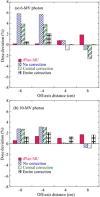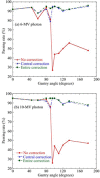Angular dependence correction of MatriXX and its application to composite dose verification
- PMID: 22955651
- PMCID: PMC5718244
- DOI: 10.1120/jacmp.v13i5.3856
Angular dependence correction of MatriXX and its application to composite dose verification
Abstract
We measured the angular dependence of central and off-axis detectors in a 2D ionization chamber array, MatriXX, and applied correction factors (CFs) to improve the accuracy of composite dose verification of IMRT and VMAT. The MatriXX doses were measured with a 10° step for gantry angles (θ) of 0°-180°, and a 1° step for lateral angles of 90°-110° in a phantom, with a 30 × 10 cm2 field for 6 MV and 10 MV photons. The MatriXX doses were also calculated under the same conditions by the Monte Carlo (MC) algorithm. The CFs for the angular dependence of MatriXX were obtained as a function of θ from the ratios of MatriXX-measured doses to MC-calculated doses, and normalized at θ = 0°. The corrected MatriXX were validated with different fields, various simple plans, and clinical treatment plans. The dose distributions were compared with those of MC calculations and film. The absolute doses were also compared with ionization chamber and MC-calculated doses. The angular dependence of MatriXX showed over-responses of up to 6% and 4% at θ = 90° and under-responses of up to 15% and 11% at 92°, and 8% and 5% at 180° for 6 MV and 10 MV photons, respectively. At 92°, the CFs for the off-axis detectors were larger by up to 7% and 6% than those for the central detectors for 6 MV and 10 MV photons, respectively, and were within 2.5% at other gantry angles. For simple plans, MatriXX doses with angular correction were within 2% of those measured with the ionization chamber at the central axis and off-axis. For clinical treatment plans, MatriXX with angular correction agreed well with dose distributions calculated by the treatment planning system (TPS) for gamma evaluation at 3% and 3 mm. The angular dependence corrections of MatriXX were useful in improving the measurement accuracy of composite dose verification of IMRT and VMAT.
Figures









References
-
- Bortfeld T. IMRT: a review and preview. Phys Med Biol. 2006;51(13):R363–R379. - PubMed
-
- Otto K. Volumetric modulated arc therapy: IMRT in a single gantry arc. Med Phys. 2008;35(1):310–17. - PubMed
-
- Cozzi L, Dinshaw KA, Shrivastava SK, et al. A treatment planning study comparing volumetric arc modulation with RapidArc and fixed field IMRT for cervix uteri radiotherapy. Radiother Oncol. 2008;89(2):180–91. - PubMed
-
- Fogliata A, Clivio A, Nicolini G, Vanetti E, Cozzi L. Intensity modulation with photons for benign intracranial tumors: a planning comparison of volumetric single arc, helical arc and fixed gantry techniques. Radiother Oncol. 2008;89(3):254–62. - PubMed
-
- Ling CC, Xhang P, Archambault Y, Bocanek J, Tang G, Losasso T. Commissioning and quality assurance of RapidArc radiotherapy delivery system. Int J Radiat Oncol Biol Phys. 2008;72(2):575–81. - PubMed
MeSH terms
LinkOut - more resources
Full Text Sources

